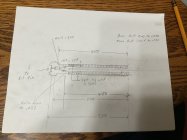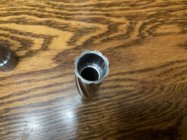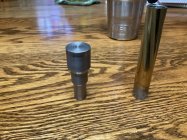I can't say that I've ever seen an action intentionally designed so the pin would bottom out anywhere other than the primer. Of course this is only with a primed case in the chamber. Without one, most bottom out on the shoulder of the pin, inside of the bolt body.
You are using an out of date browser. It may not display this or other websites correctly.
You should upgrade or use an alternative browser.
You should upgrade or use an alternative browser.
I was sent a Farley Action that had the lugs shear off of the bolt body.
- Thread starter jackieschmidt
- Start date
jackieschmidt
Gold $$ Contributor
It is the best thing ever when used in an application that it is designed for.Didn't S7 get to be a little bit of a fad back in the eighties? I remember reading an article in an old Gun Digest that made it sound like the best thing ever.
Look at my post #37 on the mechanical properties of S-7 when compared to 4140 or 4340.
All of the tensile and yield figures look great, combined with a relative high RC hardness. But the ductility, as tested by either Charpy V Notch or Izod Impact, is sorely lacking, especially in shear. If you think about the force placed on locking lugs, it is in straight shear.
I did a lot of studying on this back during the initial episodes of these failures over 20+ years ago. Now, as I study more, I would not machine a bolt from S-7.
As much as we malign the older steels of the vintage military actions, they were machined from carbon steels that while not possessing the tensile and yield properties of modern alloy steels, they did have very good ductility. Most used a case hardening process to facilitate wear ability under really abrasive conditions, (dirt and mud).
Due to the relative softness of the core steel, you might experience some lug set back if subjected to a higher pressure than the design parameters. How ever, one thing you just about never saw was the locking lugs just falling off.
Last edited:
Alex Wheeler
Site $$ Sponsor
Tikkas also stop forward travel of the pin with the cocking piece nose in the bottom of the ramp. In actual use all firing pins stop on the primer. They only stop by other means by dry firing. But you sure dont want to be stopping pin travel with the cocking piece if that wasnt the original design.
If the primer is the only means of stopping the firing pin, it begs to question why we measure protrusion at all. I suppose too little could be a problem with failure to fire but long would be a non issue?I can't say that I've ever seen an action intentionally designed so the pin would bottom out anywhere other than the primer. Of course this is only with a primed case in the chamber. Without one, most bottom out on the shoulder of the pin, inside of the bolt body.
What? Are you saying that Tikkas, stop the pin by the cocking piece, even with a primed primed case in the chamber? The one I have here has about .090 pin protrusion and yes, very lightly bottoms out at that length with no primer under it. That's more than typical and more than needed but with a primed case under it, it'll be more like .020is, which would be about .070 from bottoming out on the cocking piece.Tikkas also stop forward travel of the pin with the cocking piece nose in the bottom of the ramp. In actual use all firing pins stop on the primer. They only stop by other means by dry firing. But you sure dont want to be stopping pin travel with the cocking piece if that wasnt the original design.
That's right, and is why that's an area to improve upon many actions in this regard. Nothing wrong with room for error, etc , but we don't need that much. Maybe the factory does...with a different factory making the ammo, etc. But yes...you're exactly right in principle. Nothing wrong with what you're saying at all.If the primer is the only means of stopping the firing pin, it begs to question why we measure protrusion at all. I suppose too little could be a problem with failure to fire but long would be a non issue?
Yes, if primer indetation can never exceed say .025. then we don't need .090 protrusion.... My example for a Tikka in my previous post. Yes, the primer does in fact stop the fp.
Last edited:
LVLAaron
Gold $$ Contributor
What? Are you saying that Tikkas, stop the pin by the cocking piece, even with a primed primed case in the chamber? The one I have here has about .090 pin protrusion and yes, very lightly bottoms out at that length with no primer under it. That's more than typical and more than needed but with a primed case under it, it'll be more like .020is, which would be about .070 from bottoming out on the cocking piece.
I think he's saying the cocking piece will drop to the bottom of the cam just like the farley, but when in use, it stops on the primer.
My home made bolt has the flange on the firing pin bottoming on the tenon of the separate bolt head. When it bottoms out, there is .010 clearance ahead of the cocking piece. I have .050 pin protrusion. WH
Alex Wheeler
Site $$ Sponsor
CorrectI think he's saying the cocking piece will drop to the bottom of the cam just like the farley, but when in use, it stops on the primer.
jackieschmidt
Gold $$ Contributor
Alex, maybe you can give me a little advice.Correct
As you know, Farley’s have a rather shallow cocking helix in the bolt body. To get the pin travel near .240, you are forced to move the trigger hanger back. However, this does result in noticeable cock on close.
I would think the answer would be to increase the depth of the cocking helix and then fit everything else accordingly.
How would you increase the depth. Dremel tool and small carbide? Put it in the mill and useing tha appropriate end mill, cut the seating radius deeper and then blend the remaining helix in by hand?
Or is there some other way.?
scasa
Silver $$ Contributor
I've never cut one deeper but when making one I cut the helix in the lathe with with the milling head like in a mill with a rotary indexer and then blend it in with files and stones. probably a lot easier to do just one than dual cocking cams.Alex, maybe you can give me a little advice.
As you know, Farley’s have a rather shallow cocking helix in the bolt body. To get the pin travel near .240, you are forced to move the trigger hanger back. However, this does result in noticeable cock on close.
I would think the answer would be to increase the depth of the cocking helix and then fit everything else accordingly.
How would you increase the depth. Dremel tool and small carbide? Put it in the mill and useing tha appropriate end mill, cut the seating radius deeper and then blend the remaining helix in by hand?
Or is there some other way.?
Alex Wheeler
Site $$ Sponsor
I did my first one that way. Its doable but if the helix isnt just right it opens real nasty. I do them on the mill and could cut it for you if you like.Alex, maybe you can give me a little advice.
As you know, Farley’s have a rather shallow cocking helix in the bolt body. To get the pin travel near .240, you are forced to move the trigger hanger back. However, this does result in noticeable cock on close.
I would think the answer would be to increase the depth of the cocking helix and then fit everything else accordingly.
How would you increase the depth. Dremel tool and small carbide? Put it in the mill and useing tha appropriate end mill, cut the seating radius deeper and then blend the remaining helix in by hand?
Or is there some other way.?
S7 is no where near the correct material to use for a bolt. S7 is an impact resistant tool steel, but it does not have the ductile features and the IZOD properties (basically fracture and failure properties over time) are very low.
jackieschmidt
Gold $$ Contributor
I prepped the bolt body for the new bolt head. It’s bored to .550 inch, .775 deep. When finished machined, the bolt head insert  will be a metal to metal fit and spot tig welded in two spots to lock it.
will be a metal to metal fit and spot tig welded in two spots to lock it.
I roughed machined a piece of the E4340 to take to the heat treater tomorrow. I will have it normalized, hardened, then tempered to 38 RC.

 will be a metal to metal fit and spot tig welded in two spots to lock it.
will be a metal to metal fit and spot tig welded in two spots to lock it.I roughed machined a piece of the E4340 to take to the heat treater tomorrow. I will have it normalized, hardened, then tempered to 38 RC.


Last edited:
I prepped the bolt body for the new bolt head. It’s bored to .550 inch, .775 deep. When finished machined, the bolt head insert View attachment 1537353will be a metal to metal fit and spot tig welded in two spots to lock it.
I roughed machined a piece of the E4340 to take to the heat treater tomorrow. I will have it normalized, hardened, then tempered to 38 RC.View attachment 1537320View attachment 1537321
Very cool. I like your print as I use a #2 pencil in many of my prints as well. Looking forward to your bolt head machining pics, should be interesting. What a neat project and will get a nice action back in the game. Carry on young man.
Paul
I will take a little exception here. Excessive FP protrusion reduces the effective FP fall, the amount of fall to the point that the primer stops the pin, and this reduces the energy delivered to the primer. A lot has been written about needing enough FP fall, but of course that is all predicated on a standard of FP protrusion (.050 - .060). To better understand some things I find it useful to do a what if with an exaggerated example. Imagine that you had so much protrusion that when cocked the tip of the pin was just flush with the bolt face. That would give you less than .040 effective fall.That's right, and is why that's an area to improve upon many actions in this regard. Nothing wrong with room for error, etc , but we don't need that much. Maybe the factory does...with a different factory making the ammo, etc. But yes...you're exactly right in principle. Nothing wrong with what you're saying at all.
Yes, if primer indetation can never exceed say .025. then we don't need .090 protrusion.... My example for a Tikka in my previous post. Yes, the primer does in fact stop the fp.
I probably wasn't clear somewhere because I agree 100% and didn't mean to imply otherwise. Like I said, a little room for error is ok but .090 is a lot and yes, wasted/lost energy because of it. Those Tikkas do shoot well, though, generally of course.I will take a little exception here. Excessive FP protrusion reduces the effective FP fall, the amount of fall to the point that the primer stops the pin, and this reduces the energy delivered to the primer. A lot has been written about needing enough FP fall, but of course that is all predicated on a standard of FP protrusion (.050 - .060). To better understand some things I find it useful to do a what if with an exaggerated example. Imagine that you had so much protrusion that when cocked the tip of the pin was just flush with the bolt face. That would give you less than .040 effective fall.
WSnyder
Silver $$ Contributor
But the Tikka doesn't have a stop for the pin like a 700 so what would actually matter is what the effective pin fall is. .090" of protrusion doesn't mean much if there is no stop. When cocked how far is the pin retracted behind the bolt face? If we knew that then we could add ~.025" for pin/primer indent and come up with a reasonable number for actual pin fall.
jackieschmidt
Gold $$ Contributor
The one thing that I am not 100% sure of is machining the curved surface between the bolt lugs.Jackie, I can't wait to see what's next. Take lots of photos for us.
My best though is to grind a radius tool on a 5/8 shank HSS tool, chuck the bolt up in the lath, mount the radius tool sideways and drag the radius on the bolt.
This steel is going to be pretty tough, but it might work. I can chuck the bolt up in one of my 18 inch lathes for stiffness and power.
Last edited:
Similar threads
- Replies
- 37
- Views
- 1,450
- Replies
- 32
- Views
- 1,910
Upgrades & Donations
This Forum's expenses are primarily paid by member contributions. You can upgrade your Forum membership in seconds. Gold and Silver members get unlimited FREE classifieds for one year. Gold members can upload custom avatars.

Click Upgrade Membership Button ABOVE to get Gold or Silver Status.
You can also donate any amount, large or small, with the button below. Include your Forum Name in the PayPal Notes field.
To DONATE by CHECK, or make a recurring donation, CLICK HERE to learn how.

Click Upgrade Membership Button ABOVE to get Gold or Silver Status.
You can also donate any amount, large or small, with the button below. Include your Forum Name in the PayPal Notes field.
To DONATE by CHECK, or make a recurring donation, CLICK HERE to learn how.









